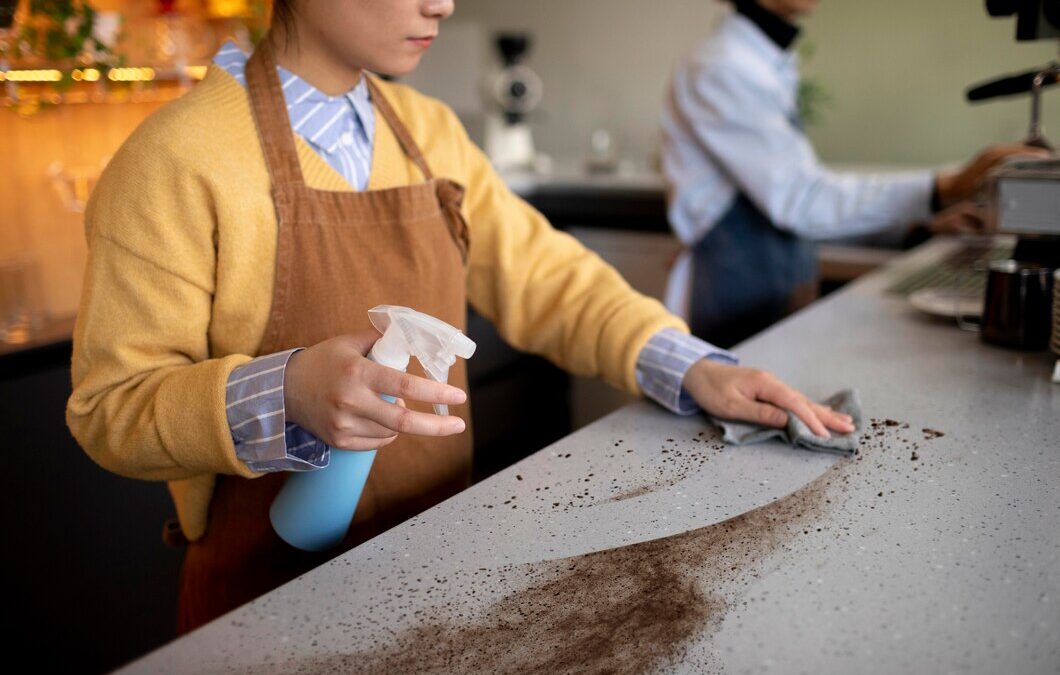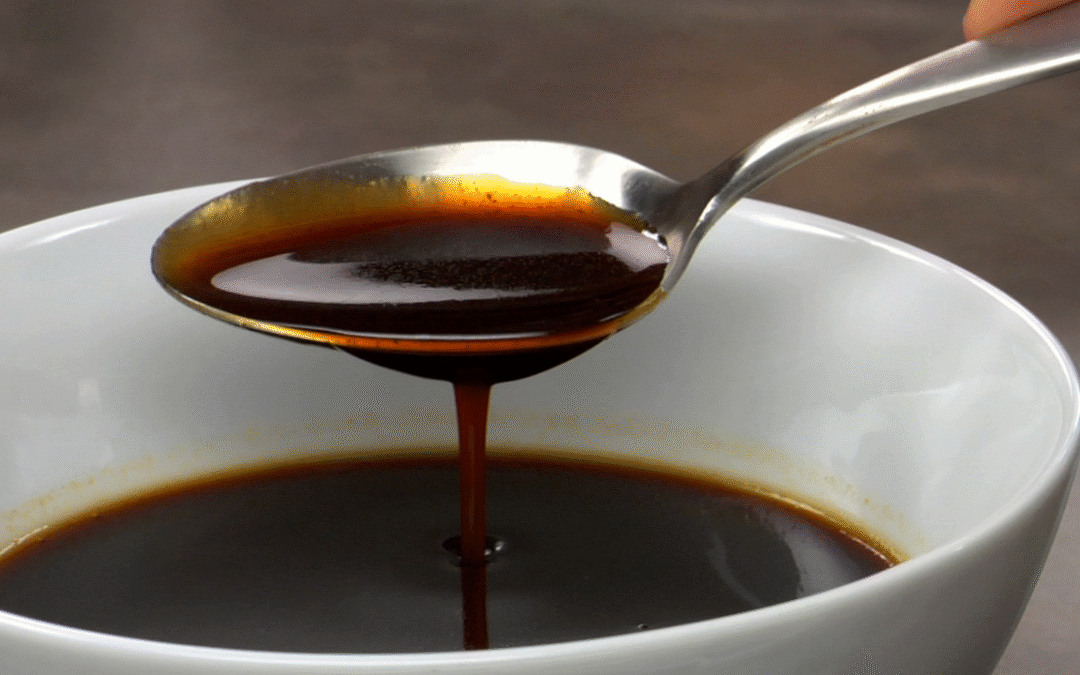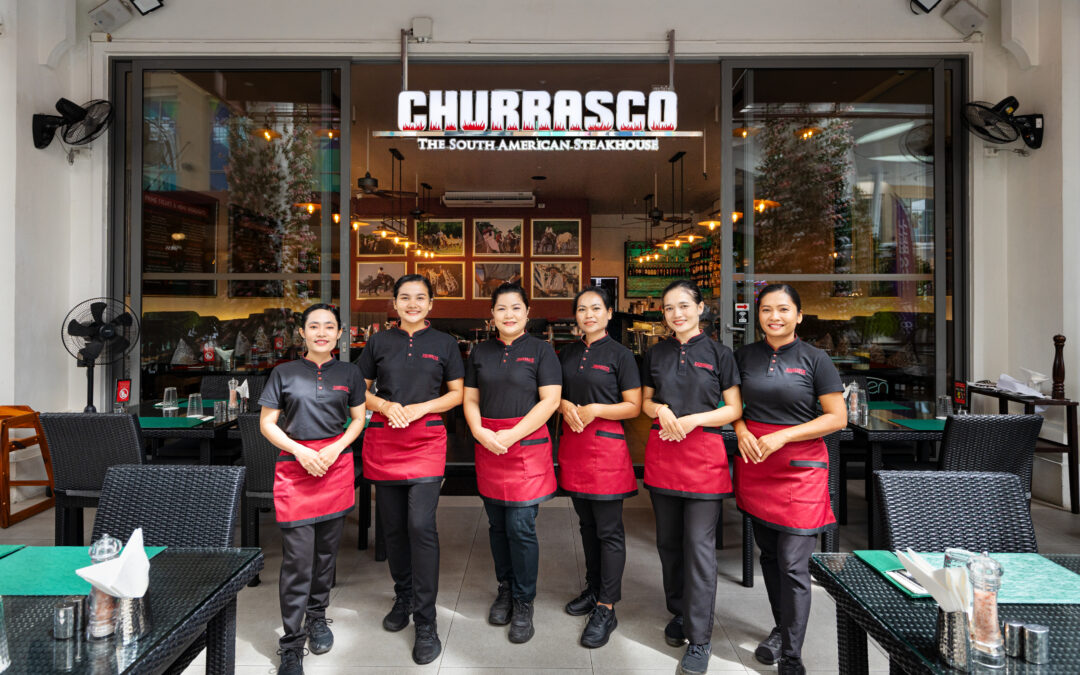
by Ross Kingsley | Feb 9, 2025 | RESTAURANT BUSINESS: BEHIND THE KITCHEN DOOR
When it comes to running a restaurant, cleaning forms one of the backbones of a successful operation. If you’ve ever watched a restaurant rescue show, you’ll notice one consistent theme: it always begins with a deep cleaning and a lot of scrubbing floors and walls. This isn’t just for dramatic effect—cleanliness is vital for food safety, customer satisfaction, as well as staff morale and discipline.
The Importance of Daily Kitchen Cleaning
A restaurant kitchen is a high-traffic, high-mess environment. By the end of service, surfaces are often coated in grease, food debris, and spills. That’s why a thorough cleaning at closing time is non-negotiable. This includes wiping down all countertops, cleaning cutting boards, scrubbing floors, and sanitizing sinks. Regular deep cleaning of ovens, exhaust fans, and refrigerators is also crucial to prevent the buildup of bacteria and mold. A clean kitchen not only ensures compliance with health codes but also sets the tone for efficient operations the next day.
Cleaning During Service
Intermittent cleaning of cooking surfaces and grills is another critical aspect of restaurant hygiene. During service, grills accumulate grease and charred food remnants, which can impact the flavor of dishes and even pose a fire hazard. Establishing a routine for wiping down surfaces and deglazing grills between busy periods keeps your kitchen functional and your dishes consistent in quality.
Bar Utensil Cleaning Routine
The bar area is often the busiest and most visible part of a restaurant, making cleanliness here a priority. Glassware, shakers, and utensils should be cleaned immediately after use to prevent sticky residue and cross-contamination. Dedicated bar sinks with proper soap and sanitizer solutions are essential. In addition, the bar area should be wiped down frequently, especially in areas prone to spills.
Restroom Cleaning
Restrooms are the deciding factor for customers when judging cleanliness. A spotless dining room is immediately overshadowed by dirty toilets. Cleaning restrooms every hour is a best practice, especially during peak hours. Regular checks should include replenishing toilet paper, soap, and paper towels while wiping down high-touch areas like door handles and faucets. It is an added cost factor, but an essential investment in success.
Dining Room Cleanliness
The dining room is the face of your restaurant. Every table should be wiped down and reset as soon as customers leave. Floors should be swept regularly, and spills should be cleaned immediately. A clean and inviting dining area ensures a positive impression on diners and enhances their overall experience.
In a restaurant, cleanliness isn’t just about appearances; it’s about creating a safe, welcoming, and efficient environment. Building strong cleaning habits from the start will set the foundation for a successful operation.
Image Credit: https://freepik.com/
_ _ _
© CHURRASCO PHUKET STEAKHOUSE / ALL RIGHTS RESERVED
>>> Reprinting, reposting & sharing allowed, in exchange for a backlink and credits <<<
Churrasco Phuket Steakhouse serves affordable Wagyu and Black Angus steaks and burgers. We are open daily from 12noon to 11pm at Jungceylon Shopping Center in Patong / Phuket.
We are family-friendly and offer free parking and Wi-Fi for guests. See our menus, reserve your table, find our location, and check all reviews here:
https://ChurrascoPhuket.com/
#Churrascophuket #jungceylon #phuketsteakhouse #affordablewagyu #wagyu

by Ross Kingsley | Feb 9, 2025 | KNOWLEDGE: MEAT ESSENTIALS
Demi-glace is a traditional meat-based French sauce known for its deep flavor and smooth texture. It is often used to enhance meats, stews, and other dishes. The name “demi-glace” means “half glaze,” referring to the process of reducing a stock and sauce into a thicker, more concentrated liquid.
Origins and History
Demi-glace has its roots in French cooking from the 17th and 18th centuries. Chefs like François Pierre La Varenne and later Auguste Escoffier developed and refined the techniques for making it. By the 19th century, demi-glace had become a key part of French cuisine, especially in fine dining.
Made With Meat
The sauce is made using a brown stock, typically prepared from roasted veal or beef bones, along with vegetables like carrots, onions, and celery. These ingredients are slowly simmered to extract flavor and gelatin, giving the sauce its rich taste and smooth texture. Traditionally, beef plays a pivotal role in the process, providing the foundation for the sauce’s signature flavor. This mixture is cooked and reduced until it reaches the right consistency. The process takes time and attention to detail, as the slow reduction allows the flavors to develop fully.
Uses and Variations
Demi-glace is used in many dishes. It can be served over steak or other meats, added to stews for extra flavor, or used as a base for other sauces like Bordelaise or Chasseur. Around the world, cooks have adapted it by using different stocks, such as chicken or fish, or even creating vegetarian versions for plant-based diets.
Why It’s Still Popular
Demi-glace continues to be an important part of cooking, valued for its ability to add flavor and texture to dishes. Whether made with traditional ingredients or adapted for modern diets, this sauce remains a versatile and practical tool in the kitchen. Its long history and adaptability ensure its place in cooking traditions today.
Image Credit: https://rouxbe.com/recipes/81-demi-glace-glace-de-viande
_ _ _
© CHURRASCO PHUKET STEAKHOUSE / ALL RIGHTS RESERVED
>>> Reprinting, reposting & sharing allowed, in exchange for a backlink and credits <<<
Churrasco Phuket Steakhouse serves affordable Wagyu and Black Angus steaks and burgers. We are open daily from 12noon to 11pm at Jungceylon Shopping Center in Patong / Phuket.
We are family-friendly and offer free parking and Wi-Fi for guests. See our menus, reserve your table, find our location, and check all reviews here:
https://ChurrascoPhuket.com/
#Churrascophuket #jungceylon #phuketsteakhouse #affordablewagyu #wagyu

by Ross Kingsley | Feb 9, 2025 | WINES: UNCORKING THE MYSTERY
Croatia, a country with a winemaking tradition dating back over 2,500 years, is one of Europe’s most underappreciated wine producers. Despite its small size, Croatia boasts a rich diversity of wines, shaped by its varied terroirs and climates. With stunning vineyards stretching from the sun-soaked Dalmatian coast to the rolling hills of the continental interior, Croatia offers an extraordinary range of flavors and styles waiting to be discovered.
Key Wine Regions
-
Dalmatia: Known for its coastal vineyards and islands, Dalmatia produces bold, sun-ripened reds and aromatic whites. Plavac Mali, a close relative of Zinfandel, is the star red grape here.
-
Istria: Often referred to as “Croatian Tuscany,” Istria is renowned for its crisp, mineral-rich Malvazija Istarska whites and elegant Teran reds.
-
Slavonia and the Danube: In the fertile eastern plains, this region is famous for Graševina (Welschriesling), a versatile white grape that produces everything from dry, fresh wines to complex, sweet dessert wines.
-
Croatian Uplands: A cooler climate area ideal for aromatic whites and sparkling wines, featuring grapes like Sauvignon Blanc and Pinot Noir.
A Storied History
Croatia’s winemaking roots trace back to the ancient Illyrians and Greeks, with the Romans further expanding viticulture. However, centuries of turmoil, including Ottoman rule and the phylloxera epidemic, disrupted wine production. During the socialist era, quantity overtook quality, but since gaining independence in the 1990s, Croatia has undergone a winemaking renaissance, with boutique producers focusing on traditional grapes and modern techniques.
Underappreciated Elegance
Despite its quality, Croatian wine remains under the radar internationally. Limited production and a focus on domestic consumption mean many top labels rarely reach global markets. However, the wines’ unique character, rooted in indigenous grapes and sustainable practices, makes them treasures for connoisseurs.
Top Grape Varieties
-
Plavac Mali: Robust reds with dark fruit and spice notes.
-
Malvazija Istarska: Fresh, citrusy whites with floral aromas.
-
Graševina: Versatile, with crisp acidity and a green apple profile.
-
Teran: Rich, earthy reds with vibrant acidity.
-
Pošip: Fruity whites with hints of Mediterranean herbs.
Top Ten Labels to Try
-
Bibich Ambra
-
Stina Pošip Majstor
-
Zlatan Plavac Grand Cru
-
Kozlović Malvazija
-
Grgić Pošip
-
Krauthaker Graševina Mitrovac
-
Saints Hills Dingač
-
Benvenuti Teran
-
Korlat Syrah
-
Tomac Millennium (sparkling)
Croatian wines offer a journey through history, revival, and innovation. Whether you’re a seasoned sommelier or a casual wine lover, discovering these underappreciated gems is an adventure worth embarking on.
Image Credit: https://wikipedia.org/
_ _ _
© CHURRASCO PHUKET STEAKHOUSE / ALL RIGHTS RESERVED
>>> Reprinting, reposting & sharing allowed, in exchange for a backlink and credits <<<
Churrasco Phuket Steakhouse serves affordable Wagyu and Black Angus steaks and burgers. We are open daily from 12noon to 11pm at Jungceylon Shopping Center in Patong / Phuket.
We are family-friendly and offer free parking and Wi-Fi for guests. See our menus, reserve your table, find our location, and check all reviews here:
https://ChurrascoPhuket.com/
#Churrascophuket #jungceylon #phuketsteakhouse #affordablewagyu #wagyu

by Ross Kingsley | Feb 9, 2025 | LIQUORS: LIFT YOUR SPIRITS
Grappa is a quintessential Italian spirit, renowned for its bold flavor and unique production process. Often misunderstood as a rustic or even harsh liquor, it is a drink steeped in regional pride. From its humble beginnings to its modern artisanal incarnations, Grappa holds a special place in Italy’s cultural and culinary heritage.
The Origins of Grappa
Grappa traces its origins back to the Northern Italian regions in the Middle Ages. It was created as a practical solution for farmers who wanted to make the most of their grape harvests. Using the leftover grape pomace—skins, seeds, and stems—from winemaking, resourceful producers distilled these remnants into a potent spirit. This waste-not approach not only conserved resources but also provided an affordable alcoholic beverage for the working class.
The name “Grappa” itself likely derives from the Latin word grappulus, meaning a small bunch of grapes, or from the Italian graspa, a dialect term for grape pomace.
Famous Regions for Grappa
Though Grappa is produced across Italy, it is most strongly associated with the northern regions. Veneto, Trentino-Alto Adige, Piedmont, and Friuli Venezia Giulia are particularly famous for their Grappa production. These areas benefit from a combination of ideal climates for grape growing and centuries-old distillation traditions.
Each region imparts its own character to the spirit. For instance, Grappa from Piedmont often features pomace from Nebbiolo grapes, used in Barolo and Barbaresco wines, giving it complex, aromatic qualities. Veneto and Friuli Venezia Giulia are known for experimenting with aging techniques, producing barrel-aged Grappas with smooth, refined flavors.
Notable Brands
Several producers have elevated Grappa to international acclaim. Poli, Nardini, and Nonino are among the most celebrated names, blending tradition with innovation. Nonino, in particular, gained recognition for pioneering single-varietal Grappas, offering spirits made from a single type of grape pomace rather than a mix.
Global Comparisons
Grappa shares similarities with other pomace brandies worldwide, such as Marc in France, Bagaceira in Portugal, and Tsipouro in Greece. Each of these spirits reflects its local terroir and winemaking traditions but follows the same fundamental practice of distilling grape byproducts.
A Modern Renaissance
Once considered a simple farmer’s drink, Grappa has undergone a transformation in recent decades. Today, artisanal Grappa is a sophisticated spirit enjoyed neat or as an after-dinner digestivo. Its versatility and heritage ensure it remains an enduring symbol of Italian flavor.
Image Credit: https://ruouxachtay.com/
_ _ _
© CHURRASCO PHUKET STEAKHOUSE / ALL RIGHTS RESERVED
>>> Reprinting, reposting & sharing allowed, in exchange for a backlink and credits <<<
Churrasco Phuket Steakhouse serves affordable Wagyu and Black Angus steaks and burgers. We are open daily from 12noon to 11pm at Jungceylon Shopping Center in Patong / Phuket.
We are family-friendly and offer free parking and Wi-Fi for guests. See our menus, reserve your table, find our location, and check all reviews here:
https://ChurrascoPhuket.com/
#Churrascophuket #jungceylon #phuketsteakhouse #affordablewagyu #wagyu

by Ross Kingsley | Feb 9, 2025 | RESTAURANT BUSINESS: BEHIND THE KITCHEN DOOR
In today’s fast-paced and competitive dining industry, personalised service has never been more important. While quality food and a welcoming ambiance are fundamental, it’s the human touch that turns a good dining experience into a great one. Personalised service creates lasting memories, builds guest loyalty, and distinguishes restaurants in a crowded market.
For diners, the appeal of personalised service lies in feeling valued. When staff remember a regular guest’s favourite dish, accommodate specific dietary needs, or go the extra mile to celebrate a special occasion, it makes customers feel appreciated. These thoughtful gestures transform the dining experience into something unique, fostering a sense of connection and belonging. Guests who feel cared for are more likely to return and recommend the establishment to others.
Loyal customers are a restaurant’s best ambassadors. Word-of-mouth referrals remain one of the most powerful ways to attract new patrons, and happy guests are eager to share their positive experiences. Personalised service drives this goodwill, ensuring diners not only enjoy their visit but also advocate for the restaurant.
In a competitive landscape, where many restaurants offer similar menus and pricing, the personal touch is a powerful differentiator. While technology has streamlined operations and introduced conveniences like online reservations, it cannot replicate the warmth of genuine human interaction. Guests appreciate the effort to make their dining experience smooth and effortless, and this emotional connection is invaluable.
Ultimately, exceptional service isn’t just about meeting expectations — it’s about exceeding them. By prioritising personalised service, restaurants can create meaningful moments that encourage repeat business and foster long-term success. Great food may bring guests in, but it’s the thoughtful service that keeps them coming back and spreading the word.
_ _ _
© CHURRASCO PHUKET STEAKHOUSE / ALL RIGHTS RESERVED
Churrasco Phuket Steakhouse serves affordable Wagyu and Black Angus steaks and burgers.
We are open daily from 12noon to 11pm at Jungceylon Shopping Center in Patong / Phuket.
We are family-friendly and offer free parking and WiFi for guests.
See our menus, reserve your table, find our location, and check all reviews here:
Home
#churrascophuket #jungceylon #phuketsteakhouse #affordablewagyu #wagyu





